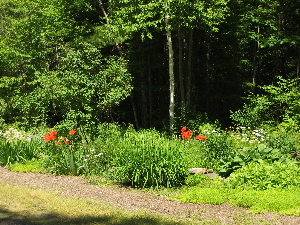Construction of a Rain Garden
• Have you ever noticed when you are traveling by airplane, how much of our landscape is covered by parking lots, roads, sidewalks and buildings? All the water that normally would have gone directly into the ground below, is now piped elsewhere. Don't let that happen in your garden. The surfaces become "funnels"...we need to have "sieves" that put the water back into the ground.
• Since this is for the "average" rainfall you should be prepared for a major downpour. Be sure to provide a way for water to drain out in this circumstance. You may want to add an outlet furrow to insure that this excess water heads in the direction YOU want!
• To test the infiltration of your soil, dig a hole 6-8 inches deep in the area that the rain garden will probably be located. Fill the hole with water. If it stays in the hole for 12 hours or more, the soil is not suitable for a rain garden. Look for another spot!
• Preferably the site for your rain garden should be in a natural depression in the landscape.
• Remember the rain garden should filter the water into the soil over a couple of hours. This area will dry out between rains eliminating problems with mosquitoes.
• After you have sited the rain garden, you will need to do a little digging.
• The depression should be 6-8 inches deep. Some areas will need to be deeper in order to make the bottom of the garden level.
• Make a berm on the down slope of the rain garden using the soil removed from the higher section. This will lessen the chance for overflow.
• The rain garden should be designed to hold no more than 6 inches of water.
• Mix organic matter into the soil by spreading 2-4 inches of compost over the area and mixing with the existing soil.
• Establish a grass or ground cover border along the upper edge of the rain garden to slow down the runoff water as it enters the garden. Do the same over the berm to stabilize it as a border for the rain garden.
• Direct sump pump water or downspout water to the rain garden by burying a 4 inch plastic drainpipe or digging a slight swale.
• Plant the plants and mulch with wood chips. Lighter mulches like pine bark and straw, will just float and wash off.
• The plants should be watered until they are established.
• Deep the weeds at bay until it is well established. Rain gardens should be relatively low maintenance if the correct plants are chosen.













